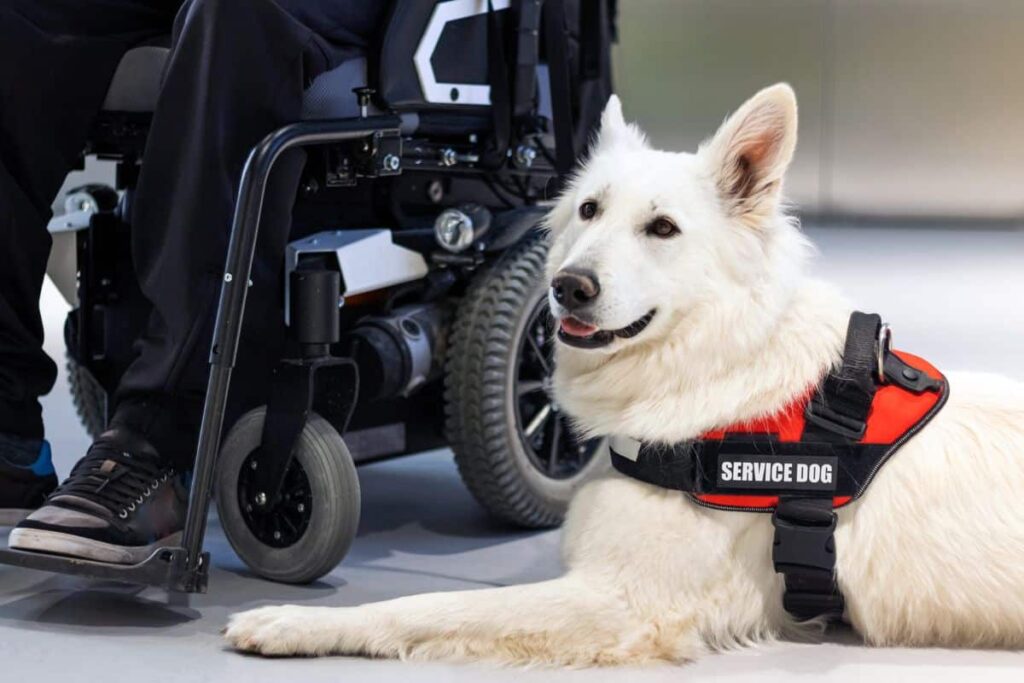Table of Contents
Service dogs play a crucial role in assisting individuals with disabilities, providing independence, and improving their quality of life. Training a dog for service work requires dedication, consistency, and a structured approach. This guide outlines the essential steps in training a dog for service work, ensuring your dog is well-prepared for the important tasks ahead.

1. Selecting the Right Dog
The first step in training a service dog is selecting the right candidate. Not all dogs are suited for service work, and it’s essential to choose a dog with the right temperament and characteristics:
- Temperament: Look for a dog that is calm, confident, and eager to please. Avoid dogs that are overly aggressive or timid.
- Health: Ensure the dog is in good health and free from genetic disorders that could affect their ability to perform tasks.
- Breed Considerations: While any breed can be trained for service work, some breeds are more commonly chosen due to their intelligence and work ethic, such as Labrador Retrievers, Golden Retrievers, and German Shepherds.
2. Basic Obedience Training
Before a dog can be trained for specific service tasks, they must master basic obedience commands. This foundation is crucial for more advanced training:
- Commands: Teach essential commands such as sit, stay, come, heel, and down.
- Consistency: Use consistent commands and rewards to reinforce good behavior.
- Positive Reinforcement: Reward your dog with treats, praise, or play to encourage obedience.
3. Socialization
Service dogs need to be well-socialized to handle various environments and situations. Proper socialization ensures your dog remains calm and focused in different settings:
- Exposure: Expose your dog to various people, animals, sounds, and environments from an early age.
- Controlled Interactions: Allow your dog to interact with new stimuli in a controlled and positive manner.
- Desensitization: Gradually desensitize your dog to potential distractions they might encounter during service work.
4. Task-Specific Training
Once your dog has mastered basic obedience and socialization, you can begin training them for specific service tasks. These tasks will vary depending on the type of service work:
- Mobility Assistance: Train your dog to help with tasks such as retrieving items, opening doors, and providing support for balance.
- Medical Alerts: For dogs trained to alert to medical conditions, such as seizures or low blood sugar, use scent training and positive reinforcement.
- Psychiatric Assistance: Train your dog to perform tasks that help mitigate the effects of psychiatric disabilities, such as interrupting harmful behaviors or providing deep pressure therapy.
5. Public Access Training
Service dogs must be well-behaved and reliable in public settings. Public access training ensures your dog can accompany you in various public places without causing disruptions:
- Manners in Public: Teach your dog to remain calm and obedient in public settings, such as stores, restaurants, and public transportation.
- Ignoring Distractions: Train your dog to ignore distractions such as other animals, people, and food.
- Controlled Behavior: Ensure your dog does not engage in behaviors such as barking, jumping, or begging while in public.
6. Certification and Testing
While certification is not legally required for service dogs in many areas, it can provide validation of your dog’s training and abilities. Consider seeking certification through a reputable organization:
- Testing: Your dog may be required to pass a series of tests to demonstrate their ability to perform service tasks and behave appropriately in public.
- Documentation: Maintain records of your dog’s training, health, and any certifications they receive.
- Ongoing Evaluation: Regularly evaluate your dog’s performance and address any issues that arise.
7. Continuous Training and Maintenance
Service dogs require ongoing training and maintenance to ensure they remain effective and reliable. Continuously reinforce training and address any new challenges:
- Regular Practice: Practice service tasks and obedience commands regularly to keep your dog’s skills sharp.
- Health Check-Ups: Schedule regular veterinary check-ups to ensure your dog remains healthy and capable of performing their duties.
- Adaptation: Be prepared to adapt training as your needs or your dog’s abilities change over time.
Conclusion on Training a Dog for Service Work
Training a dog for service work requires patience, dedication, and a structured approach. By following these seven essential steps, you can help your dog develop the skills and behaviors needed to assist individuals with disabilities effectively. Always consult with professional trainers and veterinarians to ensure the best outcomes for your service dog training. For more information and resources, visit the ASPCA and AKC.
FAQs on Training a Dog for Service Work
What breeds are best for service work?
While many breeds can be trained for service work, popular choices include Labrador Retrievers, Golden Retrievers, and German Shepherds due to their intelligence, temperament, and work ethic.
How long does it take to train a service dog?
Training a service dog can take 1-2 years, depending on the specific tasks they need to learn and the dog’s progress through training stages.
Can I train my own service dog?
Yes, you can train your own service dog. However, it is often beneficial to work with a professional trainer to ensure comprehensive and effective training.
Is certification required for service dogs?
Certification is not legally required for service dogs in many areas, but it can provide validation of your dog’s training and abilities.
What tasks can service dogs perform?
Service dogs can perform a variety of tasks, including mobility assistance, medical alerts, psychiatric assistance, and more, depending on the handler’s needs.
How do I maintain my service dog’s training?
Maintain your service dog’s training through regular practice, ongoing health check-ups, and adapting training to meet any changing needs or challenges.











